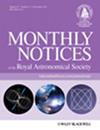The Gaia Ultracool Dwarf Sample – IV. GTC/OSIRIS optical spectra of Gaia late-M and L dwarfs
IF 4.8
3区 物理与天体物理
Q1 ASTRONOMY & ASTROPHYSICS
引用次数: 0
Abstract
As part of our comprehensive, ongoing characterisation of the low-mass end of the main sequence in the Solar neighbourhood, we used the OSIRIS instrument at the 10.4 m Gran Telescopio Canarias to acquire low- and mid-resolution (R≈300 and R≈2500) optical spectroscopy of 53 late-M and L ultracool dwarfs. Most of these objects are known but poorly investigated and lacking complete kinematics. We measured spectral indices, determined spectral types (six of which are new) and inferred effective temperature and surface gravity from BT-Settl synthetic spectra fits for all objects. We were able to measure radial velocities via line centre fitting and cross correlation for 46 objects, 29 of which lacked previous radial velocity measurements. Using these radial velocities in combination with the latest Gaia DR3 data, we also calculated Galactocentric space velocities. From their kinematics, we identified two candidates outside of the thin disc and four in young stellar kinematic groups. Two further ultracool dwarfs are apparently young field objects: 2MASSW J1246467+402715 (L4β), which has a potential, weak lithium absorption line, and G 196–3B (L3β), which was already known as young due to its well-studied primary companion.盖亚超冷矮星样本 - IV.盖亚晚M矮星和L矮星的 GTC/OSIRIS 光学光谱
作为对太阳邻近地区主序低质量末端进行全面、持续描述的一部分,我们利用 10.4 米加那利大望远镜上的 OSIRIS 仪器对 53 个晚 M 和晚 L 超冷矮星进行了中低分辨率(R≈300 和 R≈2500)光学光谱分析。这些天体中的大多数都是已知的,但研究较少,缺乏完整的运动学数据。我们测量了光谱指数,确定了光谱类型(其中六种是新的),并通过 BT-Settl 合成光谱拟合推断出所有天体的有效温度和表面重力。我们通过线中心拟合和交叉相关测量了 46 个天体的径向速度,其中 29 个天体以前没有测量过径向速度。利用这些径向速度和最新的盖亚 DR3 数据,我们还计算出了伽马中心空间速度。根据这些天体的运动学特征,我们确定了薄圆盘外的两个候选天体和年轻恒星运动组中的四个候选天体。另外两个超冷矮星显然是年轻的场天体:2MASSW J1246467+402715 (L4β)和 G 196-3B (L3β)。
本文章由计算机程序翻译,如有差异,请以英文原文为准。
求助全文
约1分钟内获得全文
求助全文
来源期刊

Monthly Notices of the Royal Astronomical Society
ASTRONOMY & ASTROPHYSICS-
CiteScore
9.10
自引率
37.50%
发文量
3198
审稿时长
3 months
期刊介绍:
Monthly Notices of the Royal Astronomical Society is one of the world''s leading primary research journals in astronomy and astrophysics, as well as one of the longest established. It publishes the results of original research in positional and dynamical astronomy, astrophysics, radio astronomy, cosmology, space research and the design of astronomical instruments.
 求助内容:
求助内容: 应助结果提醒方式:
应助结果提醒方式:


